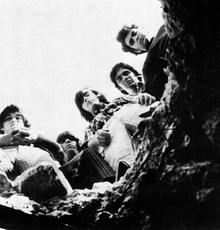Count Five
Count Five was an American garage rock band, formed in San Jose, California in 1964, best known for their hit single "Psychotic Reaction".
Count Five | |
|---|---|
 Count Five in 1966 | |
| Background information | |
| Origin | San Jose, California, U.S. |
| Genres | |
| Years active | 1964–1969 |
| Labels | Double Shot |
| Associated acts | The Count |
| Past members |
|
Background
The band was founded in 1964 by John "Mouse" Michalski (born 1948, Cleveland, Ohio) playing lead guitar and Roy Chaney (born 1948, Indianapolis, Indiana) playing bass guitar. The two were high school friends who had previously played in several short-lived bands, most notably a surf rock group named The Citations. As the British Invasion's influence took effect, the band changed in musical direction. After going by the name The Squires for a short time, along with several line-up changes, the Count Five was born. John "Sean" Byrne (1947–2008, born Dublin, Ireland) played rhythm guitar and performed lead vocals, Kenn Ellner played tambourine and harmonica, while sharing lead vocals, and Craig "Butch" Atkinson (1947–1998, born San Jose, California) played drums. The Count Five were recognizable for their habit of wearing Count Dracula-style capes when playing live.[3]
"Psychotic Reaction", an acknowledged cornerstone of garage rock,[4] was initially devised by Byrne, with the group refining it and turning it into the highlight of their live sets. The song was influenced by the style of contemporary musicians such as The Standells and The Yardbirds.[5] The band was rejected by several record labels before they got signed to the Los Angeles-based Double Shot Records. "Psychotic Reaction" was released as a single, peaking at number five in the U.S. charts in late 1966. The band enjoyed limited success for a short time, dropping out of view altogether when their only hit had fallen from public memory. Another setback to a potential career in the music business was the decision of four of the five members (who at that time were between the ages of 17 and 22) to pursue college degrees. Several months before the retirement of the band, David Eugene McDowell, the youngest player at 17 hooked up with the group as a guitar player for their last several months as a band. "Dave" shortly later went on to join up with Billy Nix and the Ideals as their Bass player.
By 1969, the Count Five had broken up, but their memory was immortalized in a 1971 essay by rock journalist Lester Bangs, entitled "Psychotic Reactions and Carburetor Dung." In the essay, Bangs credited the band for having released several later albums (after Psychotic Reaction): Carburetor Dung, Cartesian Jetstream, Ancient Lace and Wrought-Iron Railings, and Snowflakes Falling On the International Dateline — each displaying an increasing sense of artistry and refinement. However, none of these subsequent albums actually existed except in Bangs' own imagination.[6]
The Count Five reunited only once, when they performed a concert on April 11, 1987 at a club in Santa Clara, California called "One Step Beyond". This performance has been released as Psychotic Reunion LIVE!.
The song "Psychotic Reaction" can be heard playing on the jukebox in an early scene in Wim Wenders' film Alice in the Cities (1974) and in the party scene in The Sense of an Ending (2017). It can also be heard on the season one finale of the HBO drama series Vinyl.[7]
Craig Atkinson died on October 13, 1998. John "Sean" Byrne died on December 15, 2008 at 61 from cirrhosis of the liver.[8]
Roy Chaney formed a new band in the 1990s called The Count (with Byrne and drummer Rocco Astrella (born Mar 20, 1951 – died Mar 1, 2014, who played in the last version of the original group). The Count released their debut CD, Can't Sleep, in 2002. In 2006, Count Five was among the first bands inaugurated into the San Jose Rock Hall of Fame.[9]
Members
- John "Sean" Byrne – lead vocals, rhythm guitar (died 2008)
- Kenn Ellner – backing and lead vocals, tambourine, harmonica
- John "Mouse" Michalski – lead guitar
- Roy Chaney – bass guitar
- Craig "Butch" Atkinson – drums (died 1998)
- David Eugene McDowell "Dave" lead guitar;- last and youngest member 1952 -
Discography
Studio album
- Psychotic Reaction (1966)
Compilations
- Dynamite Incidents (1983)
- Psychotic Reaction (1987)
- Rarities: The Double Shot Years (2014)
Live album
- Psychotic Reunion LIVE! (1987)[10]
Singles
- "Psychotic Reaction" / "They're Gonna Get You" (1966)
- "Peace of Mind" / "The Morning After" (1966)
- "You Must Believe Me" / "Teeny Bopper, Teeny Bopper" (1967)
- "Merry-Go-Round" / "Contrast" (1967)
- "Revelation in Slow Motion" / "Declaration of Independence" (1968)
- "Mailman" / "Pretty Big Mouth" (1969)[4]
References
- "The Count Five". AllMusic.
- Nagelberg, Kenneth M. (2001). "Acid Rock". In Browne, Ray Broadus; Browne, Pat (eds.). The Guide to United States Popular Culture. Popular Press. p. 8.
- "Count Five Band Photo Gallery". countfive.com. Archived from the original on July 14, 2015. Retrieved May 11, 2015.
- Joynson, Vernon (2007). Fuzz Acid and Flowers Revisited. Glasgow, United Kingdom: Borderline Productions. p. 205. ISBN 1-899855-14-9.
- Bruce Eder. "The Count Five - Biography". allmusic.com. Retrieved May 11, 2015.
- Bangs, Lester (2003). Psychotic Reactions and Carburetor Dung (First ed.). New York: Anchor. pp. 5–19. ISBN 0-679-72045-6.
- Edwards, Gavin (2016-04-17). "'Vinyl' Season 1 Finale: As Confused as Ever". The New York Times. ISSN 0362-4331. Retrieved 2016-04-18.
- San Jose rock pioneer John Byrne of the Count Five dies at 61 Archived 2011-06-07 at the Wayback Machine
- "Inductees". San Jose Rocks. sanjoserocks.org. Retrieved 12 October 2011.
- Internet Archive - Audio Archive: Psychotic Reunion LIVE! (1987).